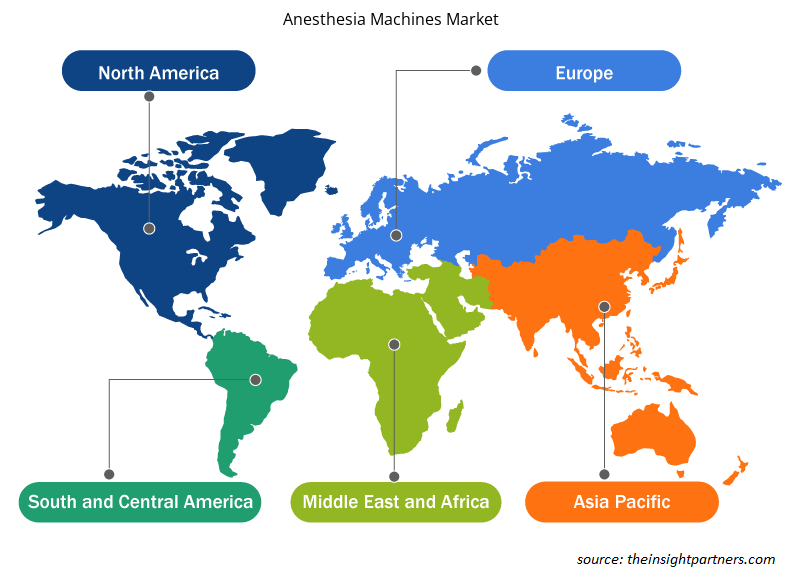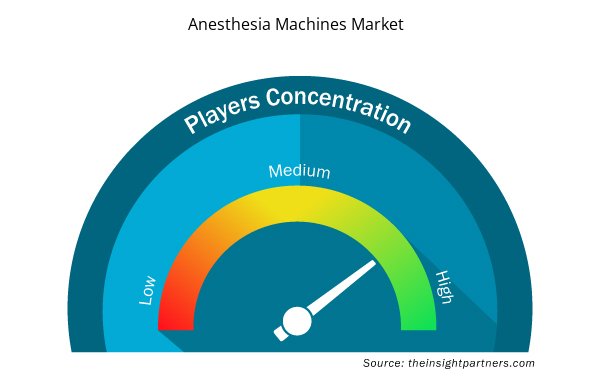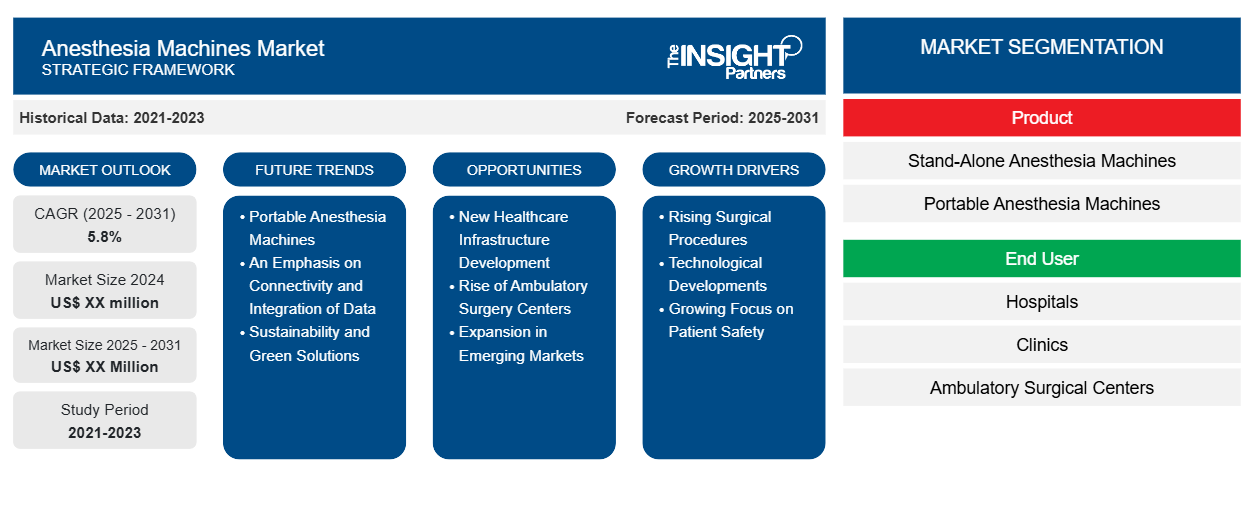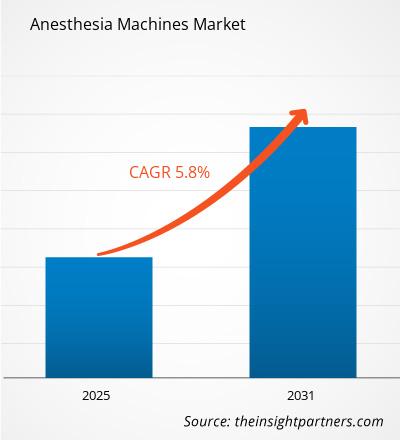Se espera que el mercado de máquinas de anestesia registre una CAGR del 5,8% entre 2024 y 2031, con un tamaño de mercado que se expandirá de US$ XX millones en 2024 a US$ XX millones en 2031.
El informe está segmentado por producto (máquinas de anestesia independientes, máquinas de anestesia portátiles). Además, está segmentado en función del usuario final (hospitales, clínicas, centros quirúrgicos ambulatorios). El análisis global se desglosa aún más a nivel regional y por países principales. El informe ofrece el valor en USD para el análisis y los segmentos anteriores.
Propósito del Informe
El informe Anesthesia Machines Market de The Insight Partners tiene como objetivo describir el panorama actual y el crecimiento futuro, los principales factores impulsores, los desafíos y las oportunidades. Esto proporcionará información a diversas partes interesadas del negocio, como:
- Proveedores/fabricantes de tecnología: Para comprender la dinámica cambiante del mercado y conocer las oportunidades potenciales de crecimiento, lo que les permitirá tomar decisiones estratégicas informadas.
- Inversionistas: Realizar un análisis exhaustivo de tendencias sobre la tasa de crecimiento del mercado, las proyecciones financieras del mercado y las oportunidades que existen en toda la cadena de valor.
- Órganos reguladores: Regular las políticas y vigilar las actividades del mercado con el objetivo de minimizar los abusos, preservar la confianza de los inversores y defender la integridad y estabilidad del mercado.
Segmentación del mercado de máquinas de anestesia
Producto
- Máquinas de anestesia autónomas
- Máquinas de anestesia portátiles
Usuario final
- Hospitales
- Clínicas
- Centros de cirugía ambulatoria
Personalice este informe según sus necesidades
Obtendrá personalización en cualquier informe, sin cargo, incluidas partes de este informe o análisis a nivel de país, paquete de datos de Excel, así como también grandes ofertas y descuentos para empresas emergentes y universidades.
- Obtenga las principales tendencias clave del mercado de este informe.Esta muestra GRATUITA incluirá análisis de datos, desde tendencias del mercado hasta estimaciones y pronósticos.
Factores impulsores del crecimiento del mercado de máquinas de anestesia
- Aumento de los procedimientos quirúrgicos: otro factor clave del mercado de las máquinas de anestesia es la cantidad de cirugías que se realizan en todo el mundo. Debido al desarrollo del sistema sanitario y al crecimiento de la población, los procedimientos que se requieren se vuelven cada vez más operativos, lo que genera una mayor necesidad de equipos de anestesia confiables. Esto, a su vez, acelera el crecimiento del mercado en todo tipo de entornos sanitarios debido a la mayor demanda de equipos de anestesia seguros y eficientes.
- Desarrollos tecnológicos: El mercado está fuertemente influenciado por la velocidad con la que se producen los avances tecnológicos en anestesia. Los avances tecnológicos en las máquinas de anestesia inteligentes que ayudan a controlar la anestesia integrada aumentan los niveles de seguridad y simplifican los procesos. Las mejoras tecnológicas han garantizado mejores resultados en los pacientes sometidos a operaciones y los proveedores de atención médica se ven obligados a invertir en nuevos equipos de anestesia.
- La creciente atención a la seguridad del paciente: el creciente énfasis en la seguridad y la comodidad del paciente se ha convertido en la fuerza impulsora del mercado de las máquinas de anestesia. Las soluciones de anestesia avanzadas que reducen los riesgos de dichos tratamientos se han convertido en el centro de atención de los hospitales y centros quirúrgicos. Este enfoque en la mejora de la atención al paciente promoverá la demanda de máquinas de anestesia sofisticadas que incorporen todas las características de seguridad más modernas.
Tendencias futuras del mercado de máquinas de anestesia
- Máquinas de anestesia portátiles: Recientemente, las máquinas de anestesia portátiles están ganando terreno debido a la tendencia de brindar servicios de cirugía móvil y en lugares remotos. Estos dispositivos livianos y pequeños garantizan una anestesia adecuada en entornos dispares; serán de gran utilidad para las personas que buscan un mejor acceso a la atención quirúrgica. Su versatilidad está captando la atención de los proveedores de atención médica, especialmente en regiones desatendidas.
- El énfasis en la conectividad y la integración de datos: tendencia creciente en el mercado de las máquinas de anestesia La conexión a registros médicos electrónicos y sistemas de monitoreo, dispositivos que pueden permitir un mejor intercambio de datos y una mejor gestión de los pacientes, han contribuido a mejoras generales en las tendencias relacionadas con la conectividad y la integración de datos. El aumento del énfasis en aumentar la eficiencia en el flujo de trabajo y los resultados en los pacientes los ha hecho más deseables en términos de soluciones integradas.
- Sostenibilidad y soluciones ecológicas: las soluciones de sostenibilidad están cobrando cada vez más influencia en el mercado de equipos de anestesia a medida que las empresas exploran innovaciones en materiales ecológicos y mejores prácticas. Poco a poco, se están adoptando los aspectos de reutilización, reducción de residuos y menor generación de residuos. Este enfoque hacia la responsabilidad medioambiental encuentra una buena sinergia e impulsa a los proveedores de atención sanitaria a utilizar soluciones de anestesia más respetuosas con el medio ambiente en los entornos clínicos.
Oportunidades de mercado en máquinas de anestesia
- Desarrollo de nuevas infraestructuras sanitarias: Se supone que el aumento de las infraestructuras sanitarias es una causa importante del crecimiento del mercado de las máquinas de anestesia, especialmente en los países en desarrollo. Con la aparición de nuevos hospitales y centros quirúrgicos, aumentará la demanda de equipos de anestesia modernos. Esto ofrecerá una buena cantidad de oportunidades para que los fabricantes entren en nuevos mercados para satisfacer las nuevas necesidades de las instalaciones sanitarias en expansión.
- Auge de los centros de cirugía ambulatoria: el desarrollo de los centros de cirugía ambulatoria (CAA) es la mayor oportunidad para las máquinas de anestesia. Debido a que las cirugías que se realizan de forma ambulatoria son cada vez más comunes e implican tiempos de preparación mucho más cortos, también aumenta la demanda de sistemas de anestesia compactos y eficientes. Esto motiva a los fabricantes a diseñar máquinas especiales que satisfagan necesidades estrictamente definidas en los CAA.
- Expansión en mercados emergentes: En los mercados emergentes, el sector de la salud ha experimentado inversiones masivas, lo que significa que existe una sucesión casi continua de oportunidades para los fabricantes de máquinas de anestesia. La inversión en mejorar la infraestructura de atención médica en estas regiones significa que existe una creciente demanda de soluciones de anestesia de alta gama. Las empresas pueden aprovechar esta oportunidad fabricando máquinas rentables y de alta calidad que cumplan con los requisitos de la creciente infraestructura médica.
Perspectivas regionales del mercado de máquinas de anestesia
Los analistas de Insight Partners explicaron en detalle las tendencias y los factores regionales que influyen en el mercado de máquinas de anestesia durante el período de pronóstico. Esta sección también analiza los segmentos y la geografía del mercado de máquinas de anestesia en América del Norte, Europa, Asia Pacífico, Oriente Medio y África, y América del Sur y Central.

- Obtenga datos regionales específicos para el mercado de máquinas de anestesia
Alcance del informe de mercado de máquinas de anestesia
| Atributo del informe | Detalles |
|---|---|
| Tamaño del mercado en 2024 | XX millones de dólares estadounidenses |
| Tamaño del mercado en 2031 | US$ XX millones |
| Tasa de crecimiento anual compuesta (CAGR) global (2025-2031) | 5,8% |
| Datos históricos | 2021-2023 |
| Período de pronóstico | 2025-2031 |
| Segmentos cubiertos | Por producto
|
| Regiones y países cubiertos | América del norte
|
| Líderes del mercado y perfiles de empresas clave |
|
Densidad de actores del mercado de máquinas de anestesia: comprensión de su impacto en la dinámica empresarial
El mercado de máquinas de anestesia está creciendo rápidamente, impulsado por la creciente demanda de los usuarios finales debido a factores como la evolución de las preferencias de los consumidores, los avances tecnológicos y una mayor conciencia de los beneficios del producto. A medida que aumenta la demanda, las empresas amplían sus ofertas, innovan para satisfacer las necesidades de los consumidores y aprovechan las tendencias emergentes, lo que impulsa aún más el crecimiento del mercado.
La densidad de actores del mercado se refiere a la distribución de las empresas o firmas que operan dentro de un mercado o industria en particular. Indica cuántos competidores (actores del mercado) están presentes en un espacio de mercado determinado en relación con su tamaño o valor total de mercado.
Las principales empresas que operan en el mercado de máquinas de anestesia son:
- Smiths Medical
- ELECTRICIDAD GENERAL
- Medtronic
- Asistencia sanitaria de Spacelabs
- Drägerwerk AG & Co. KGaA
Descargo de responsabilidad : Las empresas enumeradas anteriormente no están clasificadas en ningún orden particular.

- Obtenga una descripción general de los principales actores clave del mercado de máquinas de anestesia
Puntos de venta clave
- Cobertura integral: el informe cubre exhaustivamente el análisis de productos, servicios, tipos y usuarios finales del mercado de máquinas de anestesia, proporcionando un panorama holístico.
- Análisis de expertos: el informe se compila sobre la base de un profundo conocimiento de expertos y analistas de la industria.
- Información actualizada: El informe asegura relevancia comercial debido a su cobertura de información reciente y tendencias de datos.
- Opciones de personalización: este informe se puede personalizar para satisfacer los requisitos específicos del cliente y adaptarse adecuadamente a las estrategias comerciales.
Por lo tanto, el informe de investigación sobre el mercado de máquinas de anestesia puede ayudar a abrir camino para descifrar y comprender el escenario de la industria y las perspectivas de crecimiento. Si bien puede haber algunas preocupaciones válidas, los beneficios generales de este informe tienden a superar las desventajas.
- Análisis histórico (2 años), año base, pronóstico (7 años) con CAGR
- Análisis PEST y FODA
- Tamaño del mercado Valor/volumen: global, regional, nacional
- Industria y panorama competitivo
- Conjunto de datos de Excel



Report Coverage
Revenue forecast, Company Analysis, Industry landscape, Growth factors, and Trends

Segment Covered
This text is related
to segments covered.

Regional Scope
North America, Europe, Asia Pacific, Middle East & Africa, South & Central America

Country Scope
This text is related
to country scope.
Preguntas frecuentes
The rising surgical procedures and growing focus on patient safety are the major factors boosting the anesthesia machines market growth.
North America region accounts for highest revenue share in anesthesia machines market.
Asia Pacific is estimated to grow at the highest CAGR over the forecast period (2023 - 2031).
The anesthesia machines market is expected to grow at a CAGR of 5.8%.
The final report will duly include market size and projection estimates for all the segments from 2021 to 2031, along with a revenue share and compound annual growth rate (%) for the regional/country-wise market wherein 2021-2022 are the historic years, 2023 is considered to be the base year, and the forecast will be provided till 2031, along with CAGR (%).
Smiths Medical, GE Healthcare, and Medtronic are the major companies operating in the anesthesia machines market.
Trends and growth analysis reports related to Life Sciences : READ MORE..
The List of Companies
1. Smiths Medical
2. GENERAL ELECTRIC
3. Medtronic
4. Spacelabs Healthcare
5. Drägerwerk AG & Co. KGaA
6. BEIJING AEONMED CO., LTD.
7. HEYER Medical AG
8. Oricare, Inc.
9. BD
10. Supera Anesthesia Innovations
The Insight Partners performs research in 4 major stages: Data Collection & Secondary Research, Primary Research, Data Analysis and Data Triangulation & Final Review.
- Data Collection and Secondary Research:
As a market research and consulting firm operating from a decade, we have published and advised several client across the globe. First step for any study will start with an assessment of currently available data and insights from existing reports. Further, historical and current market information is collected from Investor Presentations, Annual Reports, SEC Filings, etc., and other information related to company’s performance and market positioning are gathered from Paid Databases (Factiva, Hoovers, and Reuters) and various other publications available in public domain.
Several associations trade associates, technical forums, institutes, societies and organization are accessed to gain technical as well as market related insights through their publications such as research papers, blogs and press releases related to the studies are referred to get cues about the market. Further, white papers, journals, magazines, and other news articles published in last 3 years are scrutinized and analyzed to understand the current market trends.
- Primary Research:
The primarily interview analysis comprise of data obtained from industry participants interview and answers to survey questions gathered by in-house primary team.
For primary research, interviews are conducted with industry experts/CEOs/Marketing Managers/VPs/Subject Matter Experts from both demand and supply side to get a 360-degree view of the market. The primary team conducts several interviews based on the complexity of the markets to understand the various market trends and dynamics which makes research more credible and precise.
A typical research interview fulfils the following functions:
- Provides first-hand information on the market size, market trends, growth trends, competitive landscape, and outlook
- Validates and strengthens in-house secondary research findings
- Develops the analysis team’s expertise and market understanding
Primary research involves email interactions and telephone interviews for each market, category, segment, and sub-segment across geographies. The participants who typically take part in such a process include, but are not limited to:
- Industry participants: VPs, business development managers, market intelligence managers and national sales managers
- Outside experts: Valuation experts, research analysts and key opinion leaders specializing in the electronics and semiconductor industry.
Below is the breakup of our primary respondents by company, designation, and region:

Once we receive the confirmation from primary research sources or primary respondents, we finalize the base year market estimation and forecast the data as per the macroeconomic and microeconomic factors assessed during data collection.
- Data Analysis:
Once data is validated through both secondary as well as primary respondents, we finalize the market estimations by hypothesis formulation and factor analysis at regional and country level.
- Macro-Economic Factor Analysis:
We analyse macroeconomic indicators such the gross domestic product (GDP), increase in the demand for goods and services across industries, technological advancement, regional economic growth, governmental policies, the influence of COVID-19, PEST analysis, and other aspects. This analysis aids in setting benchmarks for various nations/regions and approximating market splits. Additionally, the general trend of the aforementioned components aid in determining the market's development possibilities.
- Country Level Data:
Various factors that are especially aligned to the country are taken into account to determine the market size for a certain area and country, including the presence of vendors, such as headquarters and offices, the country's GDP, demand patterns, and industry growth. To comprehend the market dynamics for the nation, a number of growth variables, inhibitors, application areas, and current market trends are researched. The aforementioned elements aid in determining the country's overall market's growth potential.
- Company Profile:
The “Table of Contents” is formulated by listing and analyzing more than 25 - 30 companies operating in the market ecosystem across geographies. However, we profile only 10 companies as a standard practice in our syndicate reports. These 10 companies comprise leading, emerging, and regional players. Nonetheless, our analysis is not restricted to the 10 listed companies, we also analyze other companies present in the market to develop a holistic view and understand the prevailing trends. The “Company Profiles” section in the report covers key facts, business description, products & services, financial information, SWOT analysis, and key developments. The financial information presented is extracted from the annual reports and official documents of the publicly listed companies. Upon collecting the information for the sections of respective companies, we verify them via various primary sources and then compile the data in respective company profiles. The company level information helps us in deriving the base number as well as in forecasting the market size.
- Developing Base Number:
Aggregation of sales statistics (2020-2022) and macro-economic factor, and other secondary and primary research insights are utilized to arrive at base number and related market shares for 2022. The data gaps are identified in this step and relevant market data is analyzed, collected from paid primary interviews or databases. On finalizing the base year market size, forecasts are developed on the basis of macro-economic, industry and market growth factors and company level analysis.
- Data Triangulation and Final Review:
The market findings and base year market size calculations are validated from supply as well as demand side. Demand side validations are based on macro-economic factor analysis and benchmarks for respective regions and countries. In case of supply side validations, revenues of major companies are estimated (in case not available) based on industry benchmark, approximate number of employees, product portfolio, and primary interviews revenues are gathered. Further revenue from target product/service segment is assessed to avoid overshooting of market statistics. In case of heavy deviations between supply and demand side values, all thes steps are repeated to achieve synchronization.
We follow an iterative model, wherein we share our research findings with Subject Matter Experts (SME’s) and Key Opinion Leaders (KOLs) until consensus view of the market is not formulated – this model negates any drastic deviation in the opinions of experts. Only validated and universally acceptable research findings are quoted in our reports.
We have important check points that we use to validate our research findings – which we call – data triangulation, where we validate the information, we generate from secondary sources with primary interviews and then we re-validate with our internal data bases and Subject matter experts. This comprehensive model enables us to deliver high quality, reliable data in shortest possible time.


 Obtenga una muestra gratuita de este informe
Obtenga una muestra gratuita de este informe